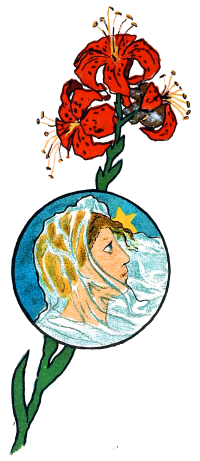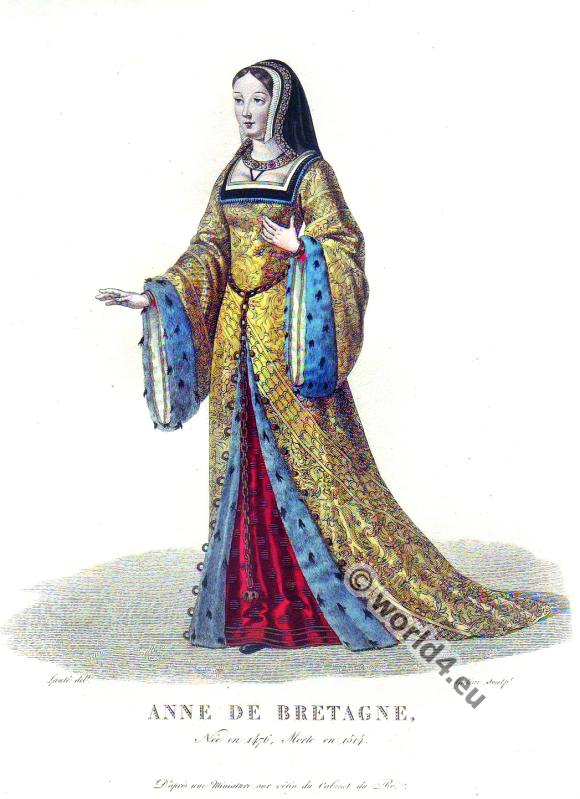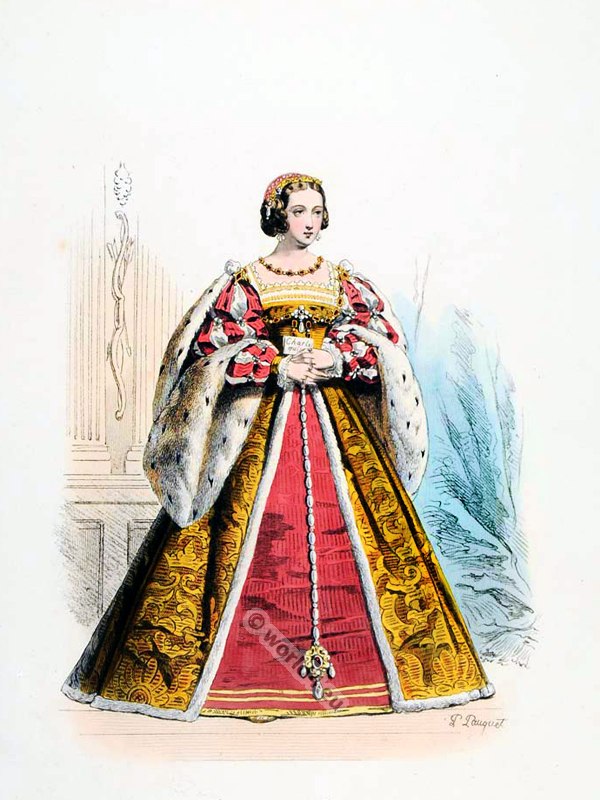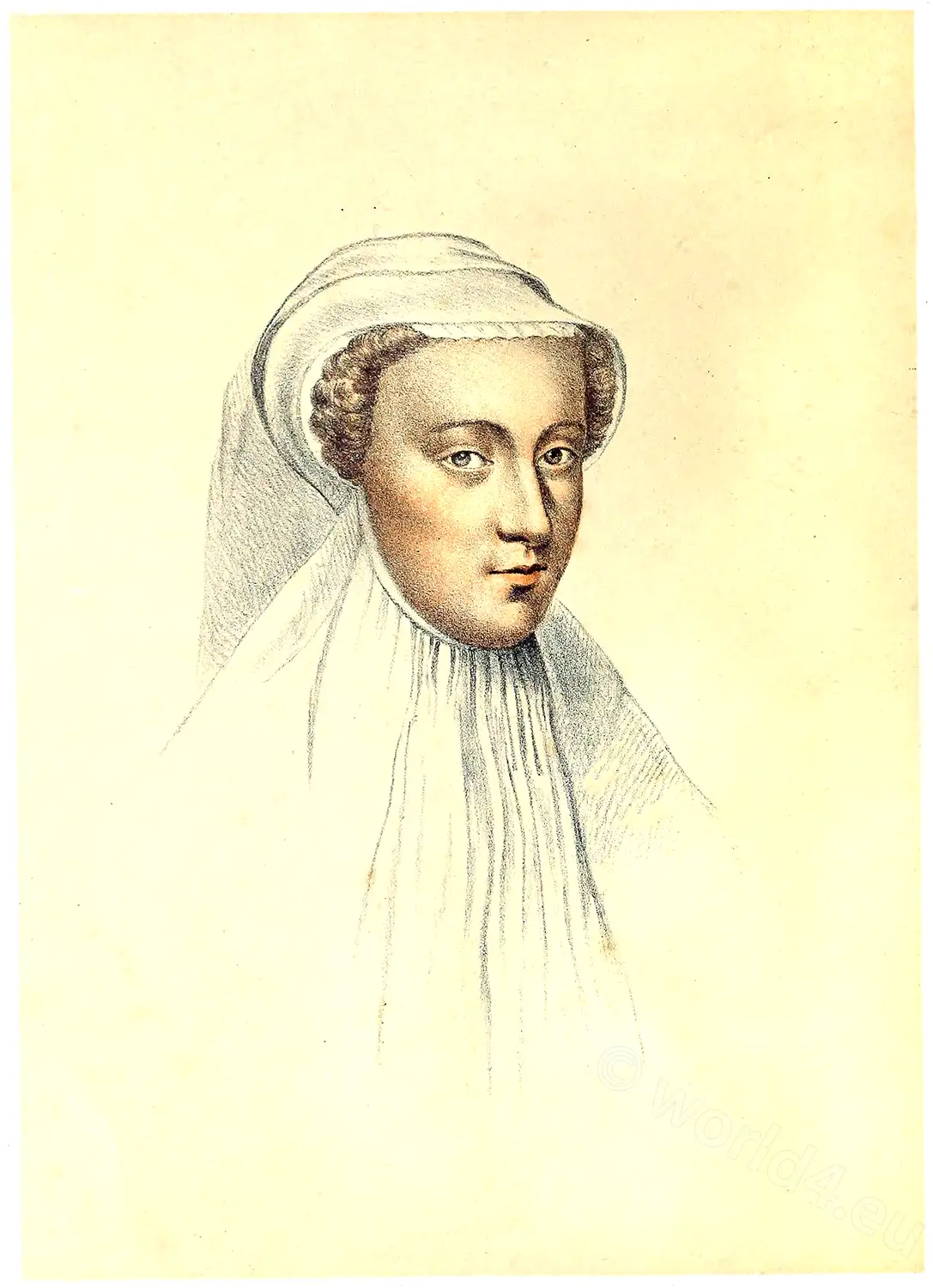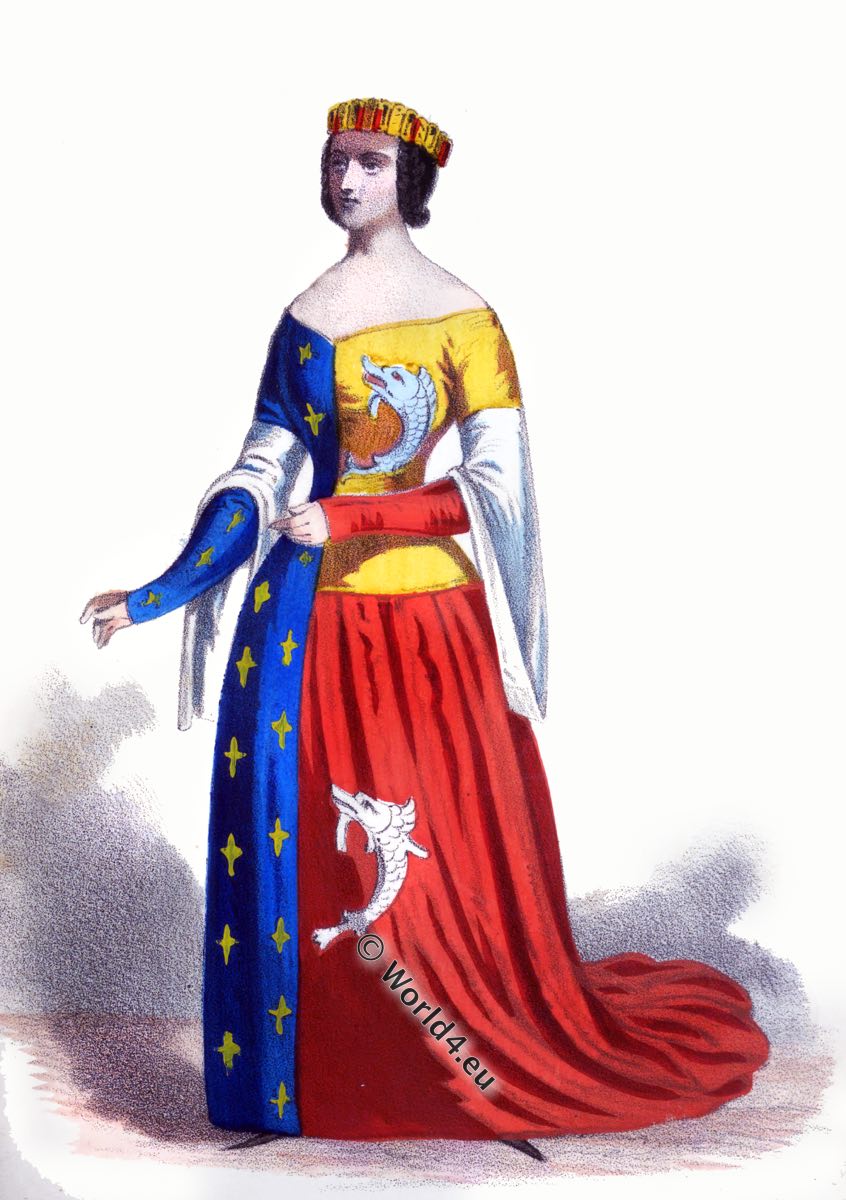
Picture: DAGOTY (attribué à J.-F. Gautier).
A mi-corps vue de face, cheveux relevés ornés de perles qui retombent avec les boucles sur les épaules, toque à plumes fixées par une aigrette de diamants, corsage fort bas surmonté d’une petite guimpe fixée sur le devant par un bijou, manteau brodé de rieurs de lis et doublé d’hermine.
Epreuve en couleurs imitant le pastel.
MARIE ANTOINETTE.
OF the French queens and royal princesses neither Marie Leszczynska, nor her daughter-in-law the Dauphine, nor, before them, the Duchesse d’Orléans, wife of the Regent, had made any attempt to assume a particular elegance, either in dress or in habits of life.
The Duchesse d’Orléans was much too lazy by nature to do anything to improve her appearance. She lay all day on her divan, while her eldest daughter, the extravagant Duchesse de Berry, joined her father, the Regent Louis-Philippe, and his commonplace mistresses, in the wild orgies of the Luxembourg.

Marie Leszczynska’s lack of elegance was founded on reasons entirely opposite. She was pious and domestic in her tastes, and spent most of the time in her apartments with needlework, with music, or with books. She hated the formality of etiquette and the grandeur of display. She was indeed the only lady at the Court of Louis XV who did not paint her face, at a time when the lavish use of rouge was universal.
When Casanova saw her for the first time, at a public dinner at Versailles, he reported: “I saw the Queen of France. She had put on no rouge, and was plainly dressed. On her head she wore a large hood, and looked old and prudish.” Even her father, the Polish King Stanislas, used to talk of the inelegance and dullness of his daughter, and he was not altogether surprised that Louis XV neglected her and turned to more attractive and more coquettish women.
She was no fool, but she cared for culture for its own sake rather than for the uses to which it might be put in society. She spoke several languages, read much-and with discrimination, was musical, understood the arts, and painted a little herself. Nevertheless she lacked that particular charm which a man seeks in a woman, and she was unfitted by nature to hold the affections of Louis. The frivolous pleasures of life held no attraction for her, and she could not understand how completely they could captivate a king. She preferred her dogs to her husband, and often kept him waiting, even at night, while she attended to their wants.
Picture: BONNET (L.), d’après M. Vanloo. (Louis-Michel van Loo)
Bust in an oval truncated at the sides. Viewed almost from the front, bare head, hair up on top of the head, at the neck a necklace of pearls tied behind by a ribbon knot, neckline bodice bordered with beehives. In the bottom margin, in the c. tr.: Mic. Vanloo, pinx ………….
L. Bonnet sculp. Marie Antoinette Dauphine from France to Paris, at Bonnet’s, rue St Jacques. Printing printed in blood red. Imitation pencil engraving.
Louis had eight daughters, six of whom grew up to be women, but none of these had any instinct for elegance. Indeed, they neglected even the amount of care in dress which might reasonably be expected in so brilliant a Court. One of their duties, on the performance of which Louis strictly insisted, was to appear at their father’s coucher, to entertain him with conversation while he was preparing for bed. They obeyed, but in most slovenly fashion.
Mme Campan tells us that as they were usually already in bed when the King began to think of retiring, and, as it was de rigueur to appear in full Court dress at the King’s coucher, they hastily flung a brocaded hoop over their night attire, tied on a train yards long, and over that put on a wide cloak of taffeta or silk, which hid the defects of their mock Court toilette. Then they ran hastily to the King, stayed with him for as short a time as possible, and ran back again in the same way, in order to creep as quickly as possible among the feather-pillows of their own beds.
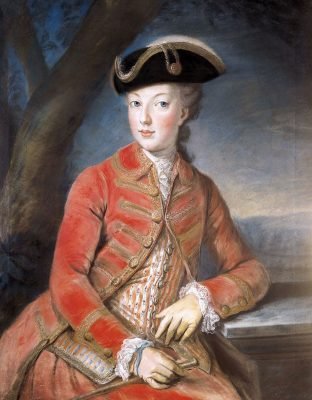
Marie-Antoinette was the first who, as Dauphine and as Queen, thought it important for the ladies of the royal family to set an example of elegance. There are even historians who lay the entire blame for the failure of the flight to Verennes on her vanity. For the Queen insisted on taking with her her coiffeur, the famous Leonard Autier, and a few of her favourite dressmakers. But Autier, like all great artists, was unreliable. He was late, and the whole plan of flight so minutely worked out was ruined.
And yet Marie-Antoinette was not altogether a vain and coquettish woman, nor was her elegance altogether consistent. Her clothes were rich and beautiful, but somewhat negligently put on, and she was often careless and untidy in her dress. Her personal cleanliness was not very strict, especially before she became Queen, and she used her bathroom but seldom. As a rule a large vessel of water brought to her room sufficed for her rapid toilet.
Her mother, Maria Theresa, in her letters, had frequently to draw attention to her daughter’s laziness in this matter, particularly to her neglect of her teeth. But we must not forget that there was nothing unusual in this.
The Rococo period, with all its luxury, was a period of dirt and lack of hygiene. Earlier it was even worse. Louis XIV hardly ever washed. He sprayed his face and hands lightly with eau de Cologne in the mornings, and had only one bath a year, in the spring. In consequence, he gave out an absolutely unbearable odour, for he suffered for years from a festering mouth sore which the doctors were unable to cure.
The manuals of etiquette of the period gave little encouragement to cleanliness. Their advice for the morning toilet was limited to the recommendation “to rub the face every morning with a white linen cloth.” The use of water is not mentioned. Even doctors held the view that too much cleanliness was injurious to health.
Regular care of the mouth and teeth was by no means common, and Marie-Antoinette paid as little attention to this as her contemporaries. Dentistry was in its infancy, and some of its practitioners little better than quacks.
The stopping of teeth, gold and silver fillings, and artificial dentures were unknown, so that the most beautiful and most elegant woman often had bad and defective teeth, revealed in all their hideousness as soon as the lovely lips were opened.
Foul breath could be partially hidden by the use of scent, and the perspiration of the body was usually veiled in the same manner. Perfumes tended to be very strong therefore, and the women of the eighteenth century were always surrounded by a stifling cloud of fragrance. But they had a wonderful gift for selecting their perfumes to suit their personalities. Indeed, this was the case with all those arts of the toilet which they employed to enhance and set off their beauty.
The use of powder and rouge was raised to the level of a fine art in the eighteenth century, and when one thinks of the great artists of the powder-puff and lipstick one cannot do better than echo Théophile Gautier in his song of praise to the secrets of the toilet:
With that rare sense of harmony which characterizes women, they have grasped that there is a disparity between full dress and everyday appearance. Just as skillful painters bring the flesh tints and draperies into harmony by the use of pale blues, women powder their skins white so that it may not appear grey beside the lace, shot silk, and satin. By this means they give their toilette a unity of tone, which is preferable to that juxtaposition of white and yellow and pink, the natural colours of the purest skin. By this fine dust they give the skin a marble gleam, and take from it the appearance of that rosy-cheeked health which for our civilization implies coarseness.
But in the period of gallantry powder and rouge did not serve alone for the simulation of a youthful and harmonious complexion. They were too often necessary in order to hide the ravages of the terrible and widely spread smallpox, for in the eighteenth century most people were scarred by this frightful disease. No rank of society was immune, and Louis XV died of it.
Marie-Antoinette’s complexion, however, was the most beautiful imaginable. Mme Vigée-Lebrun, when painting the Queen’s portrait, had difficulty in finding colours on her palette delicate enough to portray the natural bloom of the Queen’s skin. Yet Marie-Antoinette was not vain enough to give much care to her lovely body.
When she was Dauphine she even refused to wear a corset, which was an absolute necessity for the fashions of the day. It was not for reasons of health or beauty, however, that she refused to lace herself, but simply from slovenliness and love of comfort. Consequently, in comparison with the wasp waists of the other ladies, hers appeared broad and awkward.
At last she had to give way to the persuasions of her maids and her mother, and to follow the universal fashion. But Maria Theresa sent her from Vienna bodices which were not so stiffly made as the Parisian corsets.
Marie-Antoinette paid most attention to her headdress and her riding habit. She was a brilliant horsewoman, and, contrary to the custom among her French contemporaries, she always rode astride, like an Englishwoman. She looked most distinguished in her long habit of fawn cloth, her close fitting riding breeches of green velvet, her three-cornered hat, and her fair hair plaited into a pigtail like an officer’s.
As a young woman she was very slender and had small, neat hips, and on horseback she looked like a very handsome and elegant young man. Louis XV was so delighted with her appearance that, to please him, Mme du Barry used to dress in this way when she went out hunting, but even the favourite could not rival the beauty of Marie-Antoinette’s youthful body. The Princess was only just sixteen.
Picture: The young Marie Antoinette. BONNET (Assigned to 1 ). H. 0.435m.- L. 0m.319 (of tr. c). Bust in a rectangular frame. From 3/4 to dr. Hair up falling in curls over the shoulders. No letters. Colour proof; Imitation pencil engraving. “This portrait, of the utmost rarity, is considered to be one of the most rare of the most similar to the young Marie Antoinette.” (Catal. La Béraudière.)
She was a lively young woman, eager to taste the pleasures of life, and as her husband did not share her love for gaiety, but preferred to work at his lathe, she soon sought other companionship.
The Comte d’Artois, her husband’s frivolous young brother, became her habitual escort when she went stag-hunting in the Bois. He took her also to the races at Sablon, where the inexperienced girl appeared among jockeys, adventurers, and men of the world. And as Artois, after a hunt of this kind, or an expedition to the country, spent the night in the gay and wanton companionship of his friends and their mistresses in the little hunting-boxes of the district.
Court gossip was quick to declare that the young Queen had been there also. Appearances were against her. The Comte d’Artois was seen everywhere with her; he was her councillor in all worldly matters; he, the greatest libertine in Paris, of whom his kindest critics said that he was nothing but a “great, badly behaved child who, when his debaucheries and depravities left him a moment of time, was only fit for rowdiness and mischief.”
It was he who persuaded MarieAntoinette to go to the notorious Opera balls with him, where every light-minded and debauched creature in Paris was to be found. Ladies of the aristocracy and of the Court, prostitutes, adventuresses, actresses, chorus-girls, and a princess of France were brought together by the same desire for frivolity. The masks and dominoes were insufficient to guard her incognito, and Marie-Antoinette was always recognized. But other ladies of the aristocracy were there also, snatching stolen kisses under a disguise which was often only too transparent, for the mask drew attention to the face rather than concealed it.
Neglected by her husband, the young Queen was driven by the craving for change and diversion to commit grave indiscretions. It was said that she danced till five o’clock in the morning at the public balls, returned home to Versailles at half-past six, and a few hours later, at ten o’clock, set off again with the Comte d’Artois to the hunt and the races.
Her extravagance as Dauphine and as Queen was proverbial, and she was bitterly reproached for her expensive gowns, for her high headdresses and her hats decked with costly ostrich feathers. She was blamed for her passion for gambling, for her love of diamonds and other jewels, and because she was always buying new ornaments, although the splendor of the Crown jewels which she wore eclipsed anything she could possibly buy.
Even Maria Theresa heard of the extravagance of her daughter, and wrote from Vienna to admonish her: All the reports from Paris say that you have bought yourself bracelets costing 250,000 livres, and have thereby brought your financial affairs into disorder and plunged yourself into debt, and that in order to meet this you have sold some of your diamonds for a very low price.
The conclusion is that you are leading the King into superfluous extravagance, which has been increasing for some time past, and has brought the State into the hopeless condition in which it now is. . . . This French heedlessness -all these extravagant ornaments! My daughter, the best of all queens, to behave like this! The thought is unbearable!
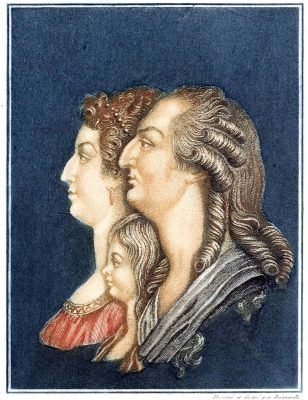
Bustes du Roi, de la Reine et du Dauphin, de profil à g. accolés. Nous laissons la responsabilité de cette attribution au compilateur du catalogue de la collection La Béraudière, sur un fond rectangulaire dans un cadre équarri suspendu par un anneau. Dans la partie blanche, entre le fond des portraits et l’encadrement, en haut: Ancien gouvernement français. En bas: Dessiné et gravé par Bonneville. Le Roi, la Reine, le Dauphin. Épreuve en couleurs. Gravure au pointillé et à l’aquatinte.
With her love of jewelry Marie-Antoinette not only set an example to the ladies of the Court and the high nobility of wearing as many diamonds as possible, but even inspired the rich women of the bourgeoisie to follow in her footsteps. The favorite gems were diamonds, emeralds, rubies, and sapphires, and those who could not afford the genuine stones wore imitations. The eighteenth century produced wonderful examples of the art of the goldsmith and jeweller, who found a market for their wares not only among women, but among men.
Monsieur the King’s brother wore a coat extravagantly embroidered in gold, on which there was hardly a square inch un-ornamented with a diamond or other precious stone. The fops bedecked themselves with jewelry in the shape of feathers, rosettes, bows and ribbons, and with gold and silver tassels. The women wore costly gems everywhere: on their clothes and in their hair; their arms, necks, and fingers were covered with diamonds.
At the theatre, at the balls, at Court, and at every kind of social function the festive appearance of the assembly owed not a little to the reflected light of all the precious stones. When Casanova visited the Opera in Paris for the first time he was particularly struck by the be-diamonded ladies who sat in the front boxes.
On the same evening he made the acquaintance of the fermier général, Beauchamps, and his wife, who invited him to dine at their house. There he obtained confirmation of the abundance, or rather of the extravagance, to be found in Paris at that period among people of the wealthy classes-a numerous company of bejeweled elegants of both sexes gambling for high stakes; there was excellent food and unbridled gaiety at table. The very stout mistress of the house herself carried on her person a fortune in pearls, diamonds, and other jewelry.
The extravagance and luxury which Marie-Antoinette later permitted herself were therefore hardly an exception. She increased and enlarged her racing stables. She beautified Trianon, distributed pensions liberally among her friends, and entertained the ladies and gentlemen of her circle to luxurious suppers, dances, and plays. But she always found her greatest amusement in gambling, particularly in the game of faro, and at this game lost enormous sums evening after evening.
Anyone who liked could, without an introduction, come up to her table and seat himself. The one condition was that he should bring with him plenty of money and be willing to lose it, for the ladies in the Queen’s circle were most arrant cheats.
There was a rumor that the Duc de Chartres, in order to please the young Queen, once lost 30,000 louis d’or in one evening. Maria Theresa was extremely unhappy at this unfortunate passion of her daughter, and trembled for her future. She gave her this warning:
Do not deceive yourself-gambling attracts bad company in every country of the world . . . the desire to win gives it too strong a hold, and in the end one is always injured . . . you must curb this passion at once; no one can give you better advice on this point than I, for I was once in the same position.
But all her mother’s warnings were of no avail, and Marie Antoinette continued to be a slave to gambling. Indeed, the passion for gambling had always been strong at the French Court, and it was not only at the Queen’s table that the stakes were high.
The Duchesse de Berry, for example, a very elegant woman with a particularly shady reputation, the daughter of the Regent and granddaughter of the honest Liselotte, lost in one evening’s play 1,800,000 francs.
Other ladies and gentlemen of the Court were not far behind her. Even Voltaire, who was avaricious and hated throwing his money away, went so far as to lose 12,000 francs at the gambling tables. At the Court of Louis XVI the tradition was carried on. But Marie Antoinette was now established as a scapegoat in the eyes of Parisians, and was held responsible for everything. It was declared that Versailles and Fontainebleau were no whit better than the gambling hells of Spa and other fashionable resorts of the period.
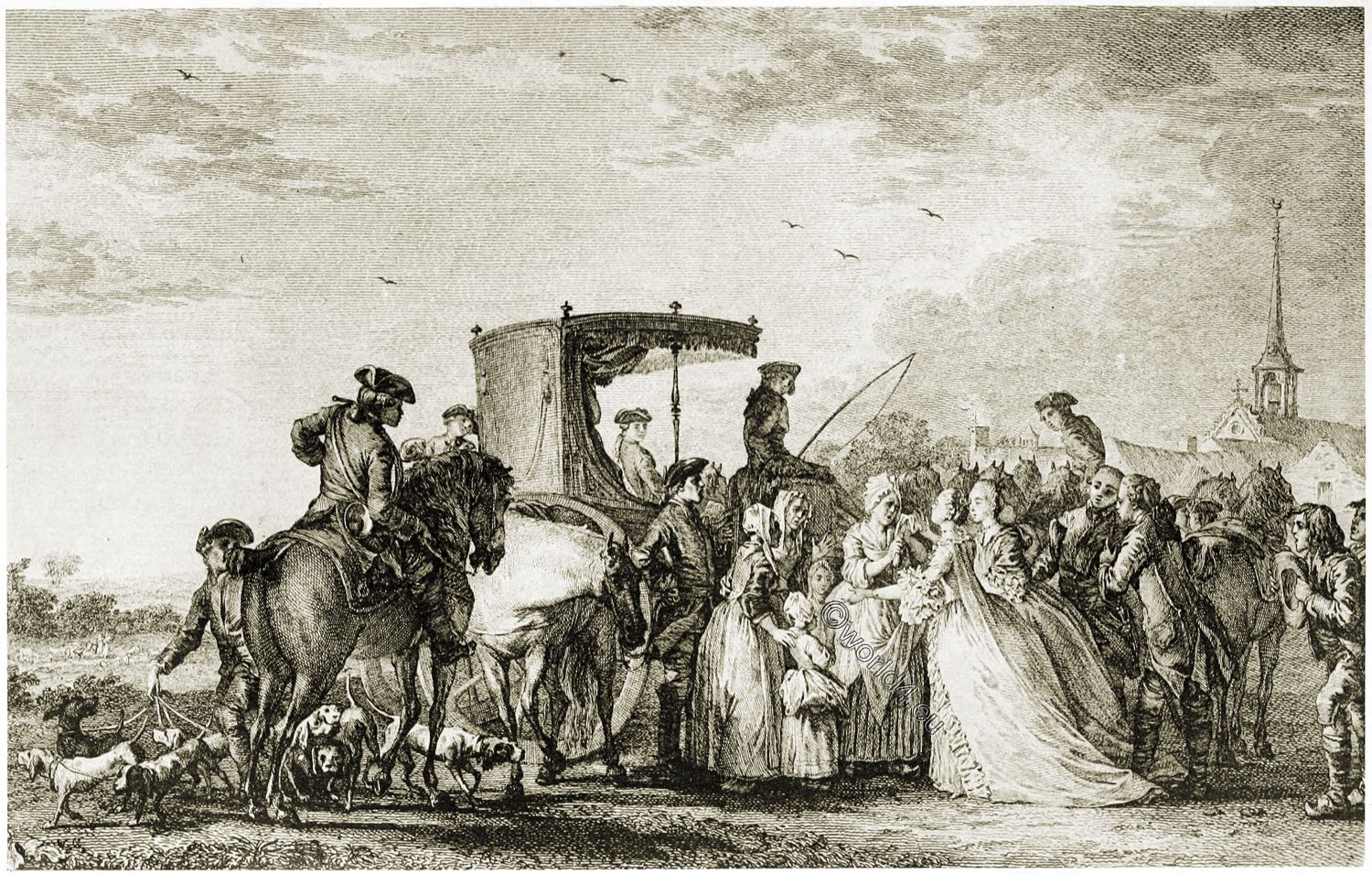
“The human trait of Madame la Dauphine”, Marie-Antoinette in conversation with the wife of a winegrower who was wounded by a deer during a hunt in the village of Achères in the forest of Fontainebleau in 1773. Graphic by François Godefroy after Moreau the Younger, Palace of Versailles. «Le trait d’humanite de Madame la Dauphine», Marie-Antoinette conslant la femme d’un vigneron blessé par un cerf au cours d’une chasse à courre au village d’Achères en forêt de Fontainebleau en 1773, Estampe, François Godefroy d’apres Moreau le Jeune, Chateau de Versailles.
Everything the Queen did was criticized adversely. She was reproached with preferring to gamble and enjoy herself rather than to become a mother. And even later, when she became a most affectionate mother to her three children, justice was not done to her. It was made a grievance against her that her first-born child could not be heir to the throne.
In this connexion it provides an interesting sidelight on the history of manners to understand what a reigning princess had to endure when the hour of delivery drew near, that hour in which the simplest woman of the bourgeoisie is guarded and cared for so that she may not be unduly excited, that hour in which every woman longs to share her pleasure in the birth of a child with her husband alone. But queens belonged to the nation, and the nation desired, and was permitted, to see not only how kings ate, but how queens bore children. At the time of Marie-Antoinette’s first confinement the public behaved in a particularly wild way.
As soon as labour had begun and the Queen had been laid upon the bed prepared for her delivery, the royal family gathered round her, while the rest of the Court, including all the ministers and Secretaries of State, awaited the great moment in the anterooms.
At the cry “The Queen is giving birth” the expectant masses, assembled outside, thronged in and mingled in noisy crowds among the courtiers, and the whole of this unrestrained mob rushed into the Queen’s bedroom, for etiquette demanded that at such a moment anybody might enter, and no one should be turned away.
When Marie-Antoinette was bearing her first child, the masses, in their joyful unrestraint, made such a wild approach to her bed that the bed-curtains, although they had been firmly secured for safety’s sake, could hardly withstand the onrush, and nearly fell on the young Queen as she lay groaning with pain and gasping for breath. Around her bed the masses thronged as though in a public square, and curious eyes had the privilege of feasting on the charms of her beautiful body, displayed with every movement. The reason for this custom was to ensure the nation against the possibility of an exchange of children and to prevent any suspicion of deception.
This description, given by Moreck in his Geschichte des Bettes, is confirmed by all contemporary and subsequent historical works concerned with the life of the unhappy French Queen.
Napoleon was the first to break the custom of public birth, for when Marie-Louise gave birth to the King of Rome the only people present in the bedroom of the patient were the doctor, the midwife, a chambermaid, and the future governess of the royal child. The happy event was announced to the members of the family and the courtiers waiting in the adjoining rooms by Napoleon himself, but the young mother received no visitors until much later.
The publicity of the Queen’s life had a pleasant as well as a disagreeable side, and her reign was marked, at least in its early period, by a series of brilliant Court festivities, an orgy of extravagance, of frivolity and grandeur, of dinners, balls, and ballets, at which she was always the brightest star.
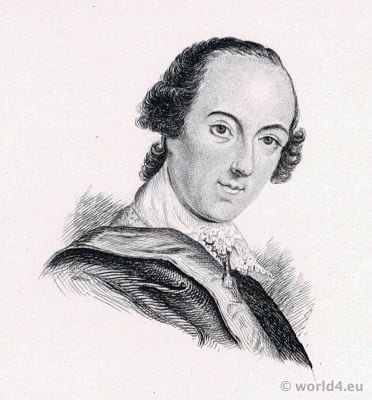
Horace Walpole, who attended one of these balls on the occasion of the marriage of Princesse Clotilde, the sister of Louis XVI, could hardly find words to express the beauty of Marie-Antoinette:
It was impossible to see anything but the Queen. Hebes and Floras, and Helens and Graces, are street-walkers to her. She is a statue of beauty, when standing or sitting; grace itself when she moves. She was dressed in silver, scattered over with laurier-roses; few diamonds, and feathers, much lower than the Monument. They say she does not dance in time, but there it is wrong to dance in time.
Frau von Oberkirch also, in her reminiscences, praises the beauty, elegance, and amiability of Marie-Antoinette. She writes about one of those great festivities at Versailles, to which many foreign royalties and guests were invited: “It is impossible to imagine so much brilliance and wealth. The toilettes were fabulous. The Queen, lovely as the day, enlivens everything with her brilliant beauty.” The worthy Maria Theresa thought otherwise about the elegance of her beautiful daughter. She considered it exaggerated, and declared:
A beautiful young queen, so full of grace, has no need of such follies: on the contrary, simplicity of dress enhances her appearance and is better suited to the rank of queen: she has but to set the tone, and a11 will hasten to adopt even her smallest eccentricities.
Marie-Antoinette, with her youth and joie de vivre, brought variety and gaiety to the otherwise monotonous and dull Court of Louis XVI. She and her equally young friends Mme de Polignac, Mme de Lamballe, the charming Duchesse d’Orléans, and other ladies of the aristocracy, such as Mmes Rohan-Guémené, Choiseul, Coigny, and Gramont, organized festivities, balls, concerts, hunting parties, and picnics.
The temperamental Queen enlivened the Court soirées at Versailles and Fontainebleau by arranging costume ballets and other festivities. She was always inventing something fresh, particularly at the Petit Trianon, that delightful refuge, which bore the stamp of her personality.
When Louis XV died, and the Trianon was no longer used by Mme du Barry, because she had to leave the Court, Marie-Antoinette asked her husband to give her the palace as a country residence. Louis XVI is said to have replied: “Madame, this beautiful spot has always been the favourite residence of the King’s favourites: it shall therefore also be yours.” Louis XVI was no phrase maker, and would never have said this, because he hated his grandfather’s mistresses, particularly the last, but he certainly made the Petit Trianon over to his wife. She accepted the gift with the greatest joy, and it became her favourite residence.
She had great social gifts, and was not only an amiable, but a very generous hostess. When the future Paul I of Russia and his wife visited the French Court in the spring of 1782 the most brilliant receptions and entertainments took place at Versailles, Fontainebleau, and the Trianon.
Marie-Antoinette devised new surprises every day for the young Archduchess. At Sèvres the Russian guests admired among other things a beautiful dressing-table set of lapis-blue china mounted with gold, a masterpiece of French porcelain-manufacture. The Archduchess Maria was enthusiastic, and cried out that she was sure it must have been made for the Queen. Imagine her surprise when she drew nearer, and found on all the pieces belonging to the set her own arms and initials! A present from Marie-Antoinette!
On the following day the Queen surprised her guest with another gift no less costly. The Archduchess Maria and Marie-Antoinette were sitting together in the charming little theatre at Versailles. “It seems to me,” suddenly said the Queen to the Archduchess, “that you are just as short-sighted as I am. But I assist my eyes with a small lorgnette discreetly arranged in my fan. Try it, and see if you can see better with it.” Thereupon she handed her her fan, richly decorated with diamonds and other precious stones, and in which a lorgnette was hidden. By a graceful movement of this fan it could be used as a pair of opera-glasses, without attracting attention to the defective sight of a beautiful woman. The Archduchess was enchanted with this invention, and was allowed to keep the costly treasure. Marie-Antoinette delighted and gave pleasure to all her guests in this free-handed manner.
The Court ceremonial had bored her even when she was Dauphine, and now that she was Queen she wanted to free herself as much as possible from its wearying round of duties. She loved nature, intimacy, free and unrestrained sociability, and found a spot, only a few steps away from the ceremonious stiffness of Versailles, where she could indulge all her tastes. Trianon was to replace for her the life of her girlhood in Schönbrunn, Austrian Residenz. All etiquette was to be banned from it.
This fancy did her more harm with her subjects than anything else- more than her love of finery, more than her frivolity and heedlessness, more than her spendthrift ways. For at the Trianon festivities, which many contemporaries and historians, particularly Mercier and the Prince de Ligne, refer to as ‘orgies,’ the Comte d’Artois was the master of ceremonies, and his bad reputation affixed itself to the place.
Here the Queen thought she and her ladies could live and dress as they liked. As a rule they wore long cambric or muslin gowns falling in soft folds, with a lace fichu pinned at the breast, and large Florentine hats trimmed with ribbons and flowers. Hoops and diamonds, trains and whalebone corsets, were banned. But this simplicity in their Queen did not suit the Parisians either, although they had long grumbled at the costly jewels, at the expensive silks for the countless frills and ruches of the hoops, at the priceless real lace, at the flowers and ribbons, at the headdresses, growing ever higher and more pretentious, and blamed Marie-Antoinette alone for all these follies of fashion.
Although they could not find enough insults to hurl at her for her superficiality and extravagance, now they were just as ready to jibe at her taste for simplicity. When she was first seen dressed as a shepherdess, and when appeared the first pictures by Mme Vigée-Lebrun of the Queen in this delightful costume, the Parisians sneered: “The Queen dresses like a serving-maid.” Others said, because her dress was only of cambric or muslin, “I suppose she wants to ruin the Lyons silk industry. For if she does not wear silk any more, other ladies will not buy it either.” Marie-Antoinette could never please the French, whether she was dressed simply or extravagantly.
Naturally the ladies of the Court did not give up their extravagant tastes even at the Trianon; simplicity was not always the watchword. Frau von Oberkirch, for instance, says that in the year 1782 she attended there the most brilliant ball she had ever known.
The most marvelous costumes of the whole season were worn on this occasion, and from six o’clock in the morning her maid was busy arranging her hair and dressing her, in order to have the complicated Court toilette and coiffure completed by the evening. She relates:
I was experimenting at that time with a very modern but extremely uncomfortable coiffure. For the latest invention of fashion was to wear little tubes filled with water arranged in the hair, so that all the live flowers used to decorate it might remain fresh. It is true this was not always successful, but, when it was, it gave the charming effect of early spring, with fresh Bowers pushing their heads through the snow of the powdered hair.
It is obvious that the ladies decked out in this way had to hold their heads very stiffly if they were not to run the risk of raining on their neighbors. Marie-Antoinette also wore one of these coiffures on the occasion in question, but particular envy was felt of another lady of the Court for her very unusual mode of hairdressing.
She wore in her hair a small gaily coloured bird made of precious stones, which at every movement hopped up and down, for it was attached to a fresh rose by a wire, so that it appeared to be hovering perpetually about the head of its lovely wearer. There were even more fantastic sights than this.
Gaston Maugras, the biographer of Lauzun, says: “These fantastic fashions seemed particularly to please Mme de Lauzun.” She had had smallpox, and appeared in Society again for the first time at Mme du Deffant’s with a noteworthy coiffure.
This erection depicted a complete landscape in relief: a stormy sea, with ducks swimming by the shore, and a hunter on the point of shooting the ducks. At the apex of the coiffure was a mill, with the miller’s wife allowing herself to be courted by a gallant priest, and at the bottom, beneath the ear, stood the miller leading an ass by the halter.
This amazing allegory was admired and laughed at, not merely for its originality, but, above all, because of its reference to the gallant character of the Duchesse, who in this way admitted her illicit escapades. There were, however, other coiffures very different from that of the Duchesse de Lauzun, in which an erotic hint was conveyed in broader fashion.
It goes without saying that with such complicated coiffures elegant ladies could not pay much attention to cleanliness of the head and hair. Indeed, very little consideration was given to personal hygiene in the eighteenth century. The hair was very rarely washed, perhaps once a year or even not at all. Elaborate coiffures were expected to last for weeks, even months, and it was no rare occurrence for vermin to nest in these monstrous edifices of hair and to attack their owners in a terrible way.
Elegant women were not allowed to scratch themselves, although very pretty gratte-tête were made. But these could be used only in private-such, at least, was the custom at the French Court. At the Court of Catherine II certainly it was different. There ladies were allowed to scratch their heads without embarrassment if they felt an itching under their coiffures.
The boudoirs and bedrooms of these elegant queens, princesses, and fine ladies, although furnished with every refinement of taste and every extravagance of luxury, left much to be desired as regards cleanliness. The royal palaces, rich with tapestries, gilding, and works of art, were none the less extremely dirty and ill-kept, not only during the reign of Louis XIV, but also a hundred years later, at the period of Marie Antoinette.
The Duke and Duchess of Saxe-Teschen were amazed and horrified when, on paying a private visit to Marie Antoinette at Versailles, they found the stairs and corridors, and even the rooms of the palace, filled with a very foul smell and covered with unspeakable dirt. The stairs in particular were covered with every kind of refuse. Even Liselotte relates that in her time ladies, with their elegant satin and brocade shoes and their long, costly Court dresses and trains, had to walk on tiptoe over the puddles and dirt, with their skirts lifted high.
Many of the corridors and stairs at the Court of Louis XIV were used as conveniences, and no attempt seems to have been made to put a stop to these vile habits. As she was not accustomed to hygiene and cleanliness, the most pampered woman did not notice the awful conditions in which she lived. All elegance was confined to outward appearance, and male and female were so much occupied with their love intrigues, their finery and fripperies, their paints and scents and lotions, that cleanliness was forgotten or neglected. The half-hearted efforts of Marie-Antoinette to bring a little hygiene into the customs of the Court were a failure, and only gave rise to censure.
In everything she had lost favour with the Parisians. She was universally considered as frivolous, superficial, fond of finery, and eager for admiration, although her extravagance and coquetry, her love of luxury and pleasure, were by no means unusual in her period.
This elegant young Queen, the last of the ancien régime, had to atone for her faults, few compared with the great crimes committed against the nation by the French Court throughout its existence, by death on the scaffold.
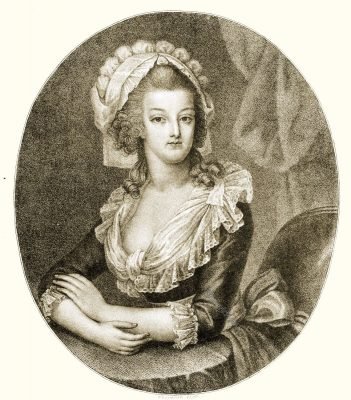
Half-length in an oval. Viewed from the front, arms folded, leaning on a table in front of her. Curly hair, lingerie bonnet, dress with low-cut bodice and half-short sleeves, kerchief. Scarf belt around the waist. Under the oval: Porporati, 1796 Marie Antoinette of Austria, Queen of France and Navarre. Print coloured before the artist’s name. Printed in black.
On her last sad journey, in the tumbril, to the place of execution, all the glory and brilliance of the once beautiful Queen were gone. She was an old woman, broken by hardship and sorrow. Absorbed in her own thoughts, she sat on one of the benches of the cart. Her hands were bound together with a rope, which the executioner held. She wore a white muslin shawl and a morning dress of white pique over a shabby black petticoat. On her hair, which she herself had cut short, and which had turned grey in the days and nights of the Terror, was a white cambric hood, framing her deathly white, exhausted face. Such was the last toilette of the once beautiful and elegant Queen Marie-Antoinette.
Source:
- The Elegant Woman by Gertrude Aretz. From the Rococo Period to Modern Times. Published by Georg G. Harrap & Co. LTD. London, 1932.
- Iconographie de la reine Marie-Antoinette by Lord Ronald Sutherland and Georges Duplessis. Paris: A. Quantin, 1883.
- L’ancienne France. Sculpteurs et architectes: l’Académie d’architecture par Paul Lacroix. Firmin-Didot (Paris) 1888.
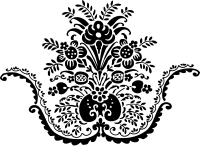
Continuing
Discover more from World4 Costume Culture History
Subscribe to get the latest posts sent to your email.




